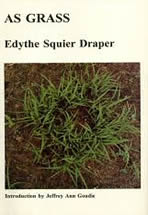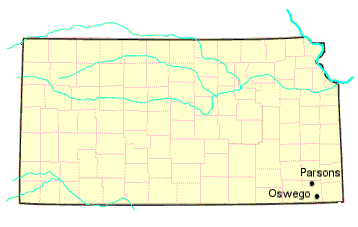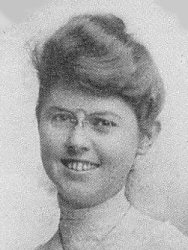
|
| Biography |
|
| |
Edythe
Squier Draper was born of missionary parents on
July 25, 1882, in Hakodate, Japan. When she was five, her family
moved from Japan to Ohio, then later to Minnesota. As the eldest
of nine children (only seven survived to adulthood), the young Edythe
had many responsibilities, often having to wash clothes and dishes
and care for her siblings. Her childhood was not easy. She wrote
later:
When I was fourteen my father - in Sinclair Lewis' old town,
Sauk Centre, Minnesota - forsook the church and all her works. He
wrote a book and we lived on - dreams, my mother and we were seven.
My father took to insurance and we had a little food and some shoes.
Edythe often felt like an outsider, as the family moved constantly.
In her autobiographical story "The Fruit at Singapore,"
she writes:
If in this town she said hain't and darsn't
in just the right places she might be chosen for Run Sheep Run,
and the girls might put their arms around her and the boys make
faces at her. No, it was no good knowing Japanese. You must not
say things, know things, the others didn't. You must be like the
girls in any town you were in, if you wanted not to be alone all
the time.
By the time Edythe graduated from high school she had lived in
Browns Valley, Crookston and Sauk Centre, Minnesota; Steubenville
and Westerville, Ohio; Asbury Park, New Jersey; and Greensburg,
Pennsylvania.
After teaching at a mission school for blacks in South Carolina,
attending the University of Pennsylvania for a time, and teaching
high school in Ohio, Edythe Squier Draper came to Oswego,
Kansas, in 1910 to join the faculty of the Oswego College for Young
Ladies. She stayed in Kansas the rest of her life. In 1912, she
married James B. Draper, whom she described as "the Man Across
the Street," then had three children and began to write. Between
1924 and 1942 she published over two dozen stories, around 60 children's
stories, and newspaper fictional short stories. Her best short story,
"The Voice of the Turtle," was reprinted in Edward J.
O'Brien's The Best Short Stories of 1930. In 1942, when
almost sixty years old, she became the Oswego correspondent to the
Parsons Sun. She wrote a daily column for the Parsons,
Kansas, newspaper until her death at age 82 on September 25, 1964.
Return to Top of Page |
|
|
Bibliography ( - housed in Thomas Fox Averill Kansas Studies Collection) - housed in Thomas Fox Averill Kansas Studies Collection) |
|
| |
Although Edythe
Squier Draper never published her novel, and gave up writing short
stories to become the Oswego correspondent to the Parsons Sun,
she saw significant publication of her short stories in literary
journals between 1924 and 1942. Here are some of those:
- Parnells, Clay, No. 3.
- Maybe So, Kansas Magazine, (1942, pp. 81-84)
*
- While the Little Flags Waved, Kansas Magazine,
(1941)
- L'il Boy, University Review,( October 6, 1939,
pp. 29-32) *
- As Her Father Her Mother, University Review,
(Summer 1938)
- Convert, Kansas Magazine, (1937)
- Quinine and Honey, Kansas Magazine, (February
1936, pp. 34-39)*
- February Idyl, Household Magazine, (February
1935)
- In Washington Tonight, Household Magazine,
(February 1932)
- I Was Young, Prairie Schooner, (Winter 1931)
- Earmark, Household Magazine, (August 1931)
- Farewell and Hail, Household Magazine, (March
1931)
- Dad and the Desert, Household Magazine, (March
1931)
- Fourteen, Midland,( May-June 1930) *
 As Grass, Prairie Schooner, (Summer 1930), Vol.
IV, no. 3, pp. 162-71;
Reprinted in "The Best Short Stories
of 1930" (New York: Dodd, Mead and Company, 1930, pp. 46-53) As Grass, Prairie Schooner, (Summer 1930), Vol.
IV, no. 3, pp. 162-71;
Reprinted in "The Best Short Stories
of 1930" (New York: Dodd, Mead and Company, 1930, pp. 46-53)
- The Voice of the Turtle, Prairie Schooner, (Summer 1929; pp. 177-84)*
- Counted Out, Household Magazine, (December 1929)
- Saint, Household Magazine,( July 1929)
- The Fruit at Singapore, Midland, (November-
December 1928)
- As It Began to Dawn, Midland, (July 1927), Vol.
12, no. 7, pp. 192-98*
- Flame Unseen, Double Dealer, (October 1924)
Return to Top of Page |
|
|
| Writing Samples |
|
| |
The excerpts below are
from the short stories collected in As Grass
“As Grass”|
It was only February, but the woman
was in her garden. She was kneeling on the ground, her small body
crouched low over it. To a casual eye she might have seemed to be
working, but she was not pulling up the bent, black stalks of last
year's vegetation; she was not planting anything; merely in contact
with the ground were her hands. She peered closely at the earth
beneath and about her, only raising her face a moment now and again
to glance at the sky, at the leafless, conical pear trees beside
the garden, or up into the maples embracing the steep roof of her
small, brown house. But always her eyes came back to the ground,
and her mouth moved in whispered question.
"What's a-goin' on? What is it
a-goin' on?"
“The Voice of the Turtle”
"Ten cents! Only ten cents!
One dime! Balloon for one dime. Only
one dime. Ten cents. Get your girl a balloon."
Ten cents! Forrest knew where
ten cents was - more than ten cents. Poppy had money he was going
to buy another cow with because old Moll's udder had got half-caked.
Pop kept the money in the old coffee-pot right there in the kitchen
above the stove. He'd go home, get the money, and come back, find
the girl, and buy a balloon, a sack of candy, everything.
He ran out of the town on roads. He
turned in at a rutted lane.
It was getting evening. The steam
piano was going up and down in the town. Voicelessly he laughed
and called back, "I'm a-comin'!"
He neared the small, sagging unporched
house there beside the river, things lying about in the yard, a
wheelbarrow without its wheel, a piece of harness, the handle and
the tooth part of a rake, overturned coops, buckets. A man, a small
man such as Forrest was getting to be, stood on the town side of
the barn. His head was stretched forward. His fingers moved, and
his knees. His brown eyes - like a hungry dog's - were open and
fixed. He laughed aloud, once, and then he became still - listening.
Two little girls with pigtails sat
on a hen-coop; an elder swung in a boardless loop of rope hanging
from a small tree. The girls were not
talking, not playing. Their mouths were open, their eyes turned
toward town. "I'll git the money. I'll git the money, go on
back. I'll git the money."
“L'il Boy”
"She a white snake, Sam. Don'
go! Don' go, Sam!"
She had got down on the floor, lips
against his feet, and had prayed to him. Now he was gone. And she
was lying in the dust, dust in her matted hair, ground into the
cuts, caking the swollen bruises on every inch of her black body.
He had chased her all around the cabin, would never have enough
of beating her. He had latched the door and beat and beat.
And then he had got himself washed,
scrubbed all over his straight body, put on the white shirt with
the tall, stiff collar she had ironed, Doc Liddell's black trousers
she had brought home and darned and washed and pressed, Postmaster
Cadwallader's coat she had ironed curtains all one day for, the
fine black shoes he had bought yesterday with the money she had
put away for the insurance. From the corner where he had at last
left her, she had heard him splash the water, swish the towel over
him, fasten on crackling shirt and collar, snap the laces in and
out of the holes of the new shoes. He had even sung a little of
one of the ritual songs, feeling fine and cool after exercise and
bath, and then he had unlatched the door and gone squeaking out.
She had done no good telling him not
to go. She was crazy.
She was crazy. Crazy fool.
She bit the back of her hand, making
pain to lessen her other pain. Her crying was all done. She was
dry of tears.
As Grass, by Edythe Squire Draper, is available to read online.
Return to Top of Page |
|
|
Art
and Life |
|
| |
The major themes of Draper's
life are paralleled in her fiction. A person who suffered hardship
as a child, a person who felt like an outsider through much of her
adult life, she sympathized with and wrote most strongly about just
such people. And her strength becomes theirs: an ability to transcend
suffering both through the use of the imagination and through contact
with the natural world. Appropriately, manyof her stories are set
in the spring, a time of natural renewal.
Return to Top of Page
|
|
|
| Primary Documents |
|
| |
Most primary documents below are from Edythe Squier Draper (1882-1964), Papers, 1865, 1907-1974 Pittsburg State Univeristy, Special Collections.
1961 Letter to daughter, Lucy
1928 Letter from Simon and Schuster
1931 Letter to son, Jim
Telephone interview with Edythe's daughter, Peg
Biographical Sketch from The Best Short Stories of 1928
1937 Letter from Margaret Widdemer
Fourteen
1921 "The Courier", Outlook
The Fruit at Singapore manuscript
Letter to her mother
Letter to Edythe's daughter, Peg from Edyth's sister, Margaret
1909 Letter accepting a job
Letter to Edward J. O'Brien
1931 Letter from Thomas H. Uzzell
Letter from Thomas H. Uzzell
1937 Letter to Hollywood agent
1938 Houghton Mifflin Letter
1929 Letter from John T. Frederick
1931 Letter from John T. Frederick
Letter from John T. Frederick
1932 Letter from Scribner's Magazine
Letter from Jacques Chambrun
Letter from Jacques Chambrun
1937 Letter from Nelson Antrim Crawford
1937 Letter from Nelson Antrim Crawford
1941 Letter from Margaret E. Dowst
Letter from Nelson Antrim Crawford
Letter from Nelson Antrim Crawford
Letter from Jacques Chambrun
1935 Letter from Simon and Schuster
1938 Letter from Houghton Mifflin
1979 Memo written by Jim Davis
1964 Edythe's son-in-law writes newspaper column
A complete list of Pittsburg State University's Axe Library can be found here.
Return to Top of Page |
|
|
| Other |
| |
Six of Draper's Kansas stories were collected by the Center for Kansas Studies and published with
an introduction by Jeffrey Ann Goudie in a volume titled As
Grass.
The book is available from the Center through: Tom Averill, MO
300, English Department, Washburn University, 1700 College, Topeka,
KS 66621, for $ 6.00.
A piece written by Edythe Squier Draper's daughter about Edyth Squier Draper
Master's Thesis on Edythe Squier Draper by Aubrey R. Streit Krug from the University of Nebraska-Lincoln
Return to Top of Page |
|
|





